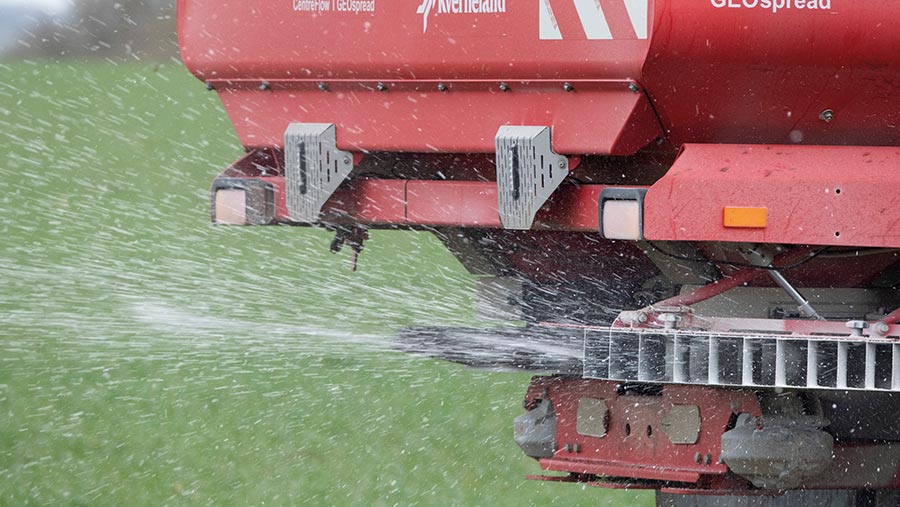Low-carbon fertilisers put to test in Bedfordshire
 © Tim Scrivener
© Tim Scrivener Fertilisers made with captured carbon dioxide and biological waste materials are being assessed on a Bedfordshire farm to see whether they can bring both productivity and environmental benefits.
In a joint collaboration between Cranfield University and CCm Technologies, the trials are being carried out at Luton Hoo Estate and will compare the use of the novel fertilisers with the farm’s standard practice.
As well as investigating whether the lower carbon fertilisers can meet a crop’s nutrient demand, the “proof of concept” work will improve the understanding of how they help to sequester soil carbon and reduce the carbon footprint of agriculture.
See also: Carbon-free fertiliser could be on farm from 2024
Climate positive
Conventional fertilisers are responsible for a large chunk of arable farming’s total emissions, so new fertiliser products with significantly lower carbon and resource footprints have the potential to offer a more sustainable approach, say the researchers working on the project.
While the environmental and social benefits of recycling and using waste streams may seem obvious, they add that the carbon savings and carbon retention associated with the fertiliser’s production method (see “How are the fertilisers made?”) show how the circular economy approach works for all.
How are the fertilisers made?
The process at the centre of CCm Technologies’ fertiliser production system combines an organic fibre, ammonia and carbon dioxide.
It starts the process with a fibrous waste material, such as straw, grass, woodchip or a partially composted material.
It then coats this with ammonia recovered from a food or animal waste stream, which allows captured carbon dioxide to react with it and attach to the cellulose by absorption.
This is then stabilised on the surface of the cellulose, making it into a carbonate material.
Additional nutrients may then be added from other selected materials, before it is pelletised for use as a fertiliser.
The basic compound fertiliser can be customised, with the nitrogen content altered or a particular formulation achieved.
“These fertilisers are taking resources that we already have – rather than using up finite reserves – stabilising the nutrients that they contain and delivering them to the crop in an available form,” says Ruben Sakrabani of Cranfield University.
“They also retain high levels of carbon within their make-up so seem to offer a soil health benefit, too, by putting organic matter and carbon into the soil,” says Dr Sakrabani.
Field trials
The Cranfield work is focusing on the impact of the fertilisers on the crop in terms of yield and quality, as well as looking at how much carbon is going back into the soil.
“We are also measuring other effects, such as any GHG [greenhouse gas] emissions or nutrient losses from leaching or run-off, as you would with any fertiliser,” he says.
This year, the team has looked at three fertilisers – containing 5%,10% and 15% nitrogen – used at four different doses across 80 plots.
The fertilisers also contained low levels of phosphorus and potassium, also sourced from the wastes, and were applied using standard farm equipment.
While harvest yields are still awaited, rhizotron tubes in the ground all season have been monitoring root growth and development, with specialised scanners used to measure root density.
At the same time, laboratory methods are being used to measure the environmental impact of the fertilisers, so that any gaseous emissions and diffuse pollution events from their use are understood.
Waste streams
By using low-value materials and wastes that would otherwise have ended up in landfill or been discharged into watercourses, the company has been able to create fertilisers with a waste component of up to 90% and a carbon footprint some 85% less than traditional products, explains Pavel Kisielewski, chief executive of CCm Technologies.
Initially developed because of the company’s ability to capture and use carbon dioxide from industrial processes, the fertiliser production method can now integrate multiple waste materials, he adds.
That means it has a place in anaerobic digestion-based water and wastewater operations, food manufacturing and processing facilities, as well as agriculture.
As such, it is already being used by recycling group Viridor to turn digestate into a low-carbon fertiliser and is being adopted by food and drinks group PepsiCo to turn the potato peelings produced at its Walkers factories into a nutrient-rich fertiliser for the company’s potato growers.
Initial results
Research to date suggests that the compound fertiliser produced by the blending of three waste components – carbon dioxide, a fibre source and ammonia – has positive effects both above and below the ground.
In terms of yield, the outcome from their use has been the same as that of conventional fertilisers, says Mr Kisielewski, who points out that trials data produced over the past six years also indicates there are environmental benefits.
Case study: Luton Hoo Estate
For estate director Edward Phillips (pictured) at Luton Hoo Estate, where the trials are taking place, fertilisers made in this way are a potential game changer for his business.

© Tim Scrivener
With about 500ha of combinable crops, Mr Phillips is very aware that the farm’s carbon footprint needs to be lowered as he looks for ways to reduce greenhouse gas emissions and reach net zero.
Having conducted a carbon footprinting exercise and discovered a 900t total, he knows how much the farm needs to do in terms of bringing its emissions down. With high-yielding Group 1 milling wheats being grown, nitrogen fertiliser use is one of the culprits.
“There are a number of things that contribute to our emissions, so finding ways of tackling them is a priority,” he says.
Planting trees may achieve some of that, but the land is productive and capable of producing food at good margins.
“We have already reduced our cultivations and made use of farmyard manure to improve our soils. Our use of artificial inputs in now under review,” he adds.
Mr Phillips is interested in being able to increase the carbon stored in the soil – for both environmental and financial reasons – and would like to know more about how these fertilisers could reduce the amount of leaching in a wet season.
“This is a really good example of how technology may be able to help us to deliver. The fact that it is cost-neutral to the farm and can be applied with our existing kit is also attractive,” he says.
Work done at the University of Sheffield in 2019 suggests that the fertiliser increases water and nutrient retention around the root ball, replenishes soil carbon and boosts soil microbial activity.
Soil carbon seems to be sequestered in two ways – carbon is found in both the calcium carbonate formed by the production process and the organic materials used. In this way, there should be a benefit seen every year from using the fertiliser in terms of storing soil carbon.
In CCm’s own trials, nitrogen volatilisation and leaching losses were considerably lower. “When you have the nutrient bound to organic matter and chalk, it’s harder for it be lost or washed down through the soil profile,” he says.
Closed loop
Taking materials from the end of their life, extracting the nutrients and sticking them together with captured carbon dioxide to produce fertilisers with a very low carbon footprint replaces the need for energy-intensive processes and finite reserves of elements such as phosphorous, adds Mr Kisielewski.
“The whole process is climate positive. The challenge with most fertiliser production globally is that it is very energy intensive and has a huge carbon footprint,” he says.
The CCm process closes the loop. “Taking waste materials and transforming them so that they are used to grow sustainable food gives farming an opportunity to help fix the environment,” adds Mr Kisielewski.

